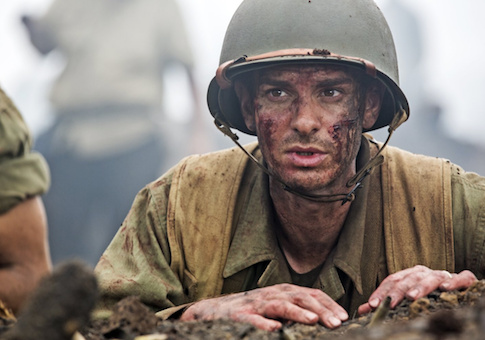Maybe 15 minutes or so into Hacksaw Ridge, two women walked out of the screening. They'd seen enough blood for their taste.
This was after a battle sequence at the beginning, a flash-forward during which we see Desmond Doss (Andrew Garfield) taken off the battlefield in a stretcher. His leg a mess, burned bodies writhing in agony, blood and guts everywhere, this is but a taste of what we'll see an hour or so later once fighting really commences.
And they made it through Doss' childhood, the most scarring moment of which involved Desmond cracking his brother Harold's head open with a brick. Harold survived, but Desmond—drawn to an embroidered Ten Commandments and staring intently at the lord's imperative not to kill as his parents struggled to bring Harold back to the land of the living—was changed that day. Never again would he raise his fist in anger at another man.
Neither battle nor brick prompted the flight from the film. No: it was blood being drawn.
Desmond, entranced by beautiful nurse Dorothy (Teresa Palmer), sits down in a hospital chair and offers up his veins just for the chance to chat with her. The needle—one of those big relics from hospitals past, a mean-looking thing—goes into his arm with a faint, but unmistakable, little "pop." The blood poured forth into its receptacle and the two women ran-walked out of the theater, as fast as their legs could take them.
I harp on this because Hacksaw Ridge is a great but unrepentantly bloody film, one that is not for the weak of stomach nor faint of heart. For a film about a man who won the Congressional Medal of Honor despite the fact that he refused to carry a rifle into battle—a refusal that earned him a court martial and nearly led to him spending World War II in a brig—Hacksaw Ridge isn't squeamish about delving into combat's dirtier side.
A Seventh Day Adventist, Doss isn't a pacifist exactly. He understands the need to combat the Japanese and the Germans, and recoils at the idea of not doing his part in the war effort. He recognizes that evil must be met with violence and that the enemy must be killed. His conscience simply won't allow him to do the killing; he wants to serve as a medic, saving lives instead of taking them.
Hacksaw Ridge is, in its own way, delightfully old fashioned. Doss' unit is made up of a motley cross-section of America. There's a guy from Brooklyn, a guy from California, a smart guy, a quiet guy, a funny guy, a guy in glasses, etc. They go through boot camp and then into combat in the Pacific under the guidance of gruff-but-lovable Sergeant Howell (Vince Vaughn) and the stern-but-benevolent Captain Glover (Sam Worthington).
Once in combat, there is no effort made to empathize with the other side. The Japanese Army is a screaming, treacherous horde: unintelligible sneaks swarming over our heroes, gunning them down, bayonetting them, attacking while waving a white flag.
Indeed, at one point—when Japanese soldiers came streaming out of underground tunnels, the hillside covered with moving bodies—I jotted the word "Klendathu" in my notes. This, of course, is the site of the disastrous battle in Paul Verhoeven's Starship Troopers, a parody of wartime propaganda films. Hacksaw Ridge plays, in many respects, like an un-ironic version of Starship Troopers. Both films are structured similarly (a wounding in battle; a flashback to the wounded soldier's childhood; a trip through boot camp; inevitable progress back to the battle, and wounding, in the opening) and are similarly unconcerned about the enemy.
Mel Gibson's first directorial effort since the sadly underrated Apocalypto does not feel like a particularly ambiguous examination of the horrors of war. Doss the pacifist may be the protagonist, but he (and we) are glad that he's surrounded by grunts willing to wield weapons to keep him safe while he drags the wounded from the battlefield. The movie is, instead, a straight-ahead celebration of honor and virtue and sacrifice.
As I said, a bit old fashioned. But undeniably effective. And one of the best pictures of the year.
